Amsterdam and Poland 2017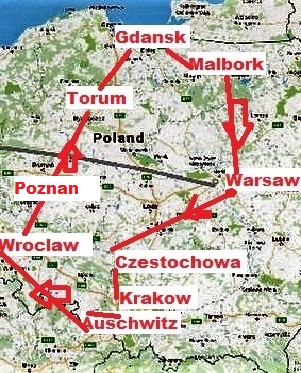
Day 12, Thursday, June 15
Poznan and Torun
We left at 8:00 this morning headed north for Poznan, which was not
on the original schedule but Collette included it as a free
surprise extra stop.
Poznań is among the oldest and largest cities in Poland. The city
population is about 550,000. Poznań is a center of trade, sports,
education, technology, and tourism. It is an important academic site,
with about 130,000 students at the Adam Mickiewicz University - the
third largest Polish university.
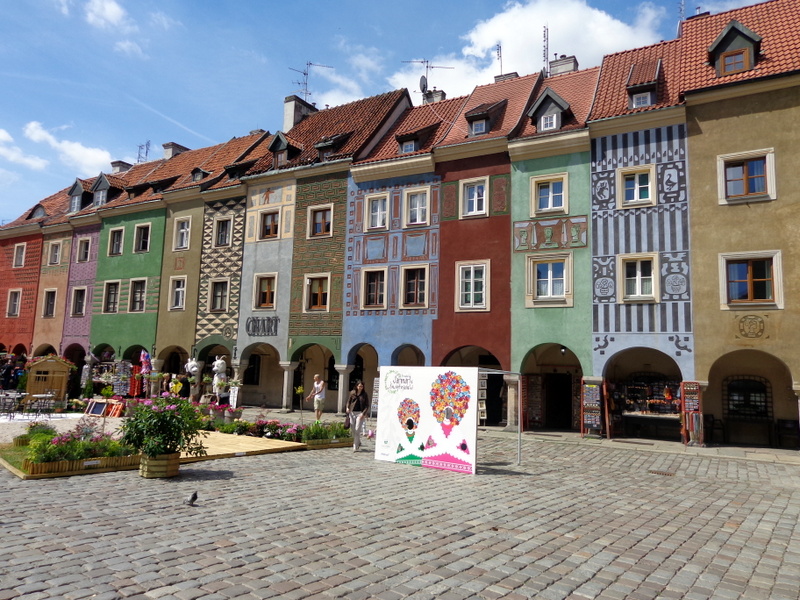 Today is Corpus Christi Day, which is a legal holiday in Poland.
Churches have huge processions on this day. The bus had a hard time
getting near the market square because of the procession. We walked
into the main square and found it a very festive town with wonderful
buildings. We enjoyed seeing Polish parents with their children
enjoying the sun and the ice cream in the market square.
Today is Corpus Christi Day, which is a legal holiday in Poland.
Churches have huge processions on this day. The bus had a hard time
getting near the market square because of the procession. We walked
into the main square and found it a very festive town with wonderful
buildings. We enjoyed seeing Polish parents with their children
enjoying the sun and the ice cream in the market square.
As we entered the square, a beautiful stately Town Hall with an
almost green hew, faced us. The Town Hall, which is Italian in style,
was originally constructed as the administrative building of the city.
It was completed around 13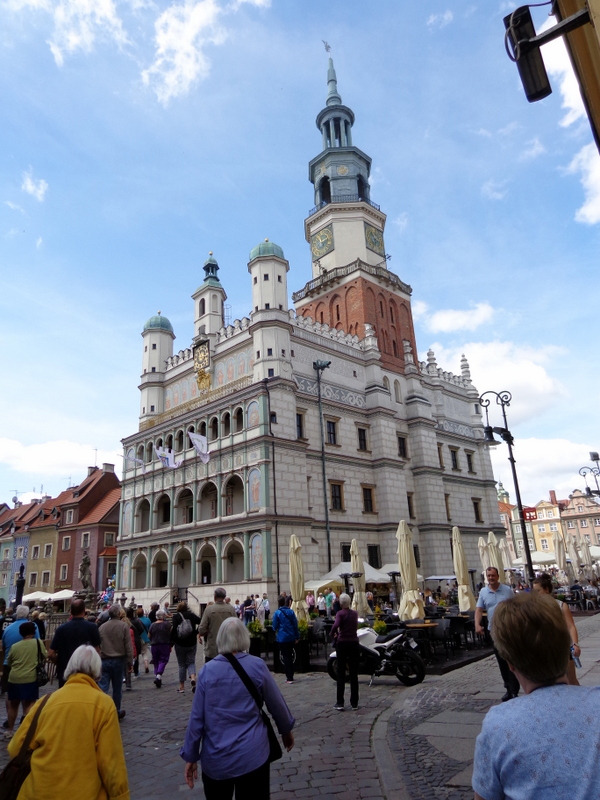 00, during the reign of Wenceslaus II of
Bohemia.
00, during the reign of Wenceslaus II of
Bohemia.
Originally, it was a one-story Gothic building built upon a raised
quadrangle. The cellars remain from this period of construction. The
building was extended in the 15th century, and at the turn of the
century a tower was built at the north-western corner. The interior was
remodeled between 1504 and 1508.
In 1536 the city suffered a major fire, which did serious damage to
the town hall. Repair work was carried out in 1540–1542, particularly to
the tower, but it remained unsafe to carry out a major rebuilding. The
work lasted until 1560. Di Quadro added an upper story, extended the
building towards the west, and added attic walls and a three-story
loggia.
A new clock, installed 1551, was made with three full faces
and one half-face, and with goats added as a "comic element". I’ll tell
y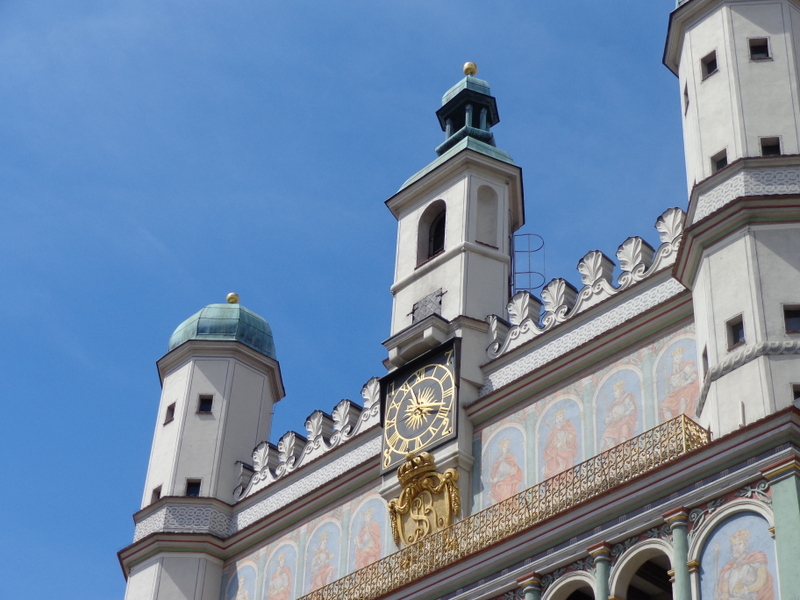 ou about the goats below.
ou about the goats below.
In 1675 the tower, clock and goats were destroyed by lightning. The
tower was rebuilt in 1690 to a height of 300 ft. The top of the tower
was destroyed in a hurricane of 1725. In 1781–1784 major renovation was
carried out on the building and it obtained the basic form which it
presents today. The next major renovation was carried out in 1910–1913,
during the period of German rule.
Following major damage in the The Battle of Poznan in 1945, the Town
Hall was again rebuilt in 1945–1954. Extracts from the constitution of
the Polish peoples Republic were painted on the exterior attic walls.
The eagle, which had been kept hidden during the war, was returned to
the tower in 1947. Th e mechanism that drives the goats was replaced in
1954, and again at the end of the century. Renovation carried out in
1992–2002 largely restored the building to its post-1784 appearance.
e mechanism that drives the goats was replaced in
1954, and again at the end of the century. Renovation carried out in
1992–2002 largely restored the building to its post-1784 appearance.
I have mentioned the goats several times. We were able to see the
goats perform today at noon. The mechanical goats' butting display is
performed daily at noon, preceded by the striking of the clock and the
playing of a traditional bugle call. I am sorry that I was not able to
get a front view of the goats, but there was a huge crowd in the front.
A legend behind the original
addition of the goats to the clock mechanism states that a cook, while
preparing a banquet for the military leader and other dignitaries, had
burnt a roast deer, and attempted to replace it by stealing two goats
from a nearby meadow. The goats escaped and ran up the town hall tower,
where they attracted the attention of the townspeople when they began to
butt each other. Because of the entertainment provided, the military
officer pardoned both the cook and the goats, and ordered that two
mechanical goats be incorporated into the new clock being made for the
building.
We were then on our own to look around and have lunch while in
Poznan.
 We found a wonderful large church to visit at one side of the square
at the end of a short street off of the square,
the Church of St. Stanislaus the Bishop,
often referred to as the “Parish Church”. Because of its location at
the end of the street, it was impossible to photo the entire church,
only a part of its beautiful Baroque façade. It is renowned as one of
the most exquisite examples of Baroque in Polish architecture. It is
also one of the largest churches in Poland.
We found a wonderful large church to visit at one side of the square
at the end of a short street off of the square,
the Church of St. Stanislaus the Bishop,
often referred to as the “Parish Church”. Because of its location at
the end of the street, it was impossible to photo the entire church,
only a part of its beautiful Baroque façade. It is renowned as one of
the most exquisite examples of Baroque in Polish architecture. It is
also one of the largest churches in Poland.
The history of the Church of St Stanislaus is closely connected with
the Jesuits who came to Wroclaw in 1571 invited by Bishop Adam Konarski.
The city authorities gave the Jesuits a complex of buildings, consisting
of the Church of St. Stanislaus the Bi shop, a chapel, a school and a
plot of land, by. Soon Poznan became one of the most significant Jesuit
centers in Poland. The church turned out to be too small, so the Jesuits
purchased the plots of land adjacent to the church and started building
a new church. Its construction began in 1651.The erection of the church
was interrupted by the Swedish invasion, so the consecration took place
in 1705.
shop, a chapel, a school and a
plot of land, by. Soon Poznan became one of the most significant Jesuit
centers in Poland. The church turned out to be too small, so the Jesuits
purchased the plots of land adjacent to the church and started building
a new church. Its construction began in 1651.The erection of the church
was interrupted by the Swedish invasion, so the consecration took place
in 1705.
The pink and white facade is a work of Giovanni Catenazzi; the main
portal was designed by Pompeo Ferrari. In the niche above the entrance
there is a statue of St Ignatius of Loyola, the founder of the Jesuit
Order.
 The interior of the church is awesome as well. The rich adornments
of the interior include massive artificial marble columns with the
apostle statues on top, the 17th-century polychromy walls and ceiling
featuring the scenes from the life of St. Stanislaus on the vaulting of
the main nave, and the pseudo-dome painting on the nave crossing. The
high altar, with a painting featuring St. Stanislaus the Bishop bringing
back Piotrowin to life (1756) with huge st
The interior of the church is awesome as well. The rich adornments
of the interior include massive artificial marble columns with the
apostle statues on top, the 17th-century polychromy walls and ceiling
featuring the scenes from the life of St. Stanislaus on the vaulting of
the main nave, and the pseudo-dome painting on the nave crossing. The
high altar, with a painting featuring St. Stanislaus the Bishop bringing
back Piotrowin to life (1756) with huge st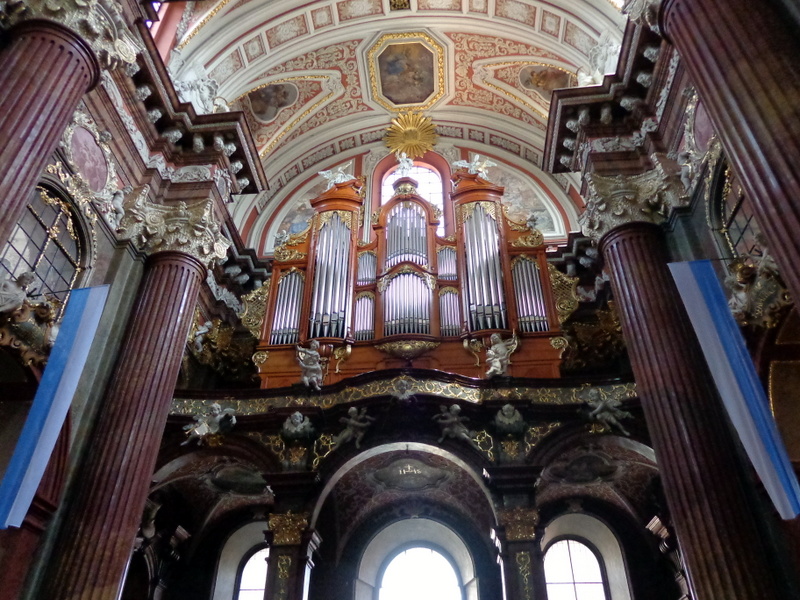 atues of St. Stanislaus the
Bishop and St. Stanislaus Kostka at its sides.
atues of St. Stanislaus the
Bishop and St. Stanislaus Kostka at its sides.
It certainly was a magnificent church on the inside. We are so
pleased we found it. Then we run into two of our travelling friends, and
had lunch with them.
We left Poznan and drove to Torun where we are to spend the night.
We checked in our hotel and then we went to a Gingerbread Museum where
we made Gingerbread Cookies.
Why was this stop on our tour? It seems that the art of making
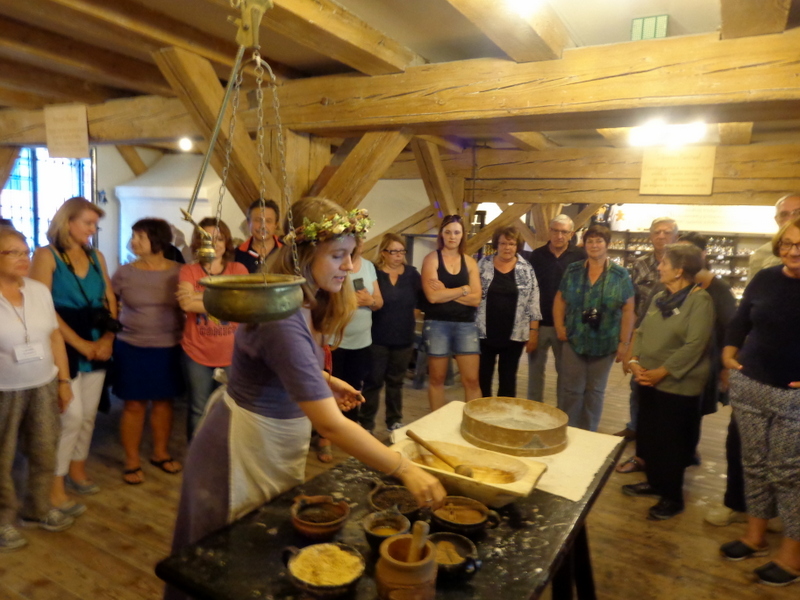 gingerbread has its origins in the Germanic countries of the Baltic
seas, making it one of the oldest traditional baked goods in Europe
gingerbread has its origins in the Germanic countries of the Baltic
seas, making it one of the oldest traditional baked goods in Europe
In the 13th century, as trade routes spread through Europe to Asia
and the Middle East and access to spices from the Far East became more
readily available, gingerbread production and quality dramatically
increased.
Commercialized production of the gingerbread trade began to take
root Toruń. The largest production facility was owned by Gustav Traugott
Weese in the early 1900s. Today, his house has been turned into an
interactive gingerbread museum where visitors can learn about the
histo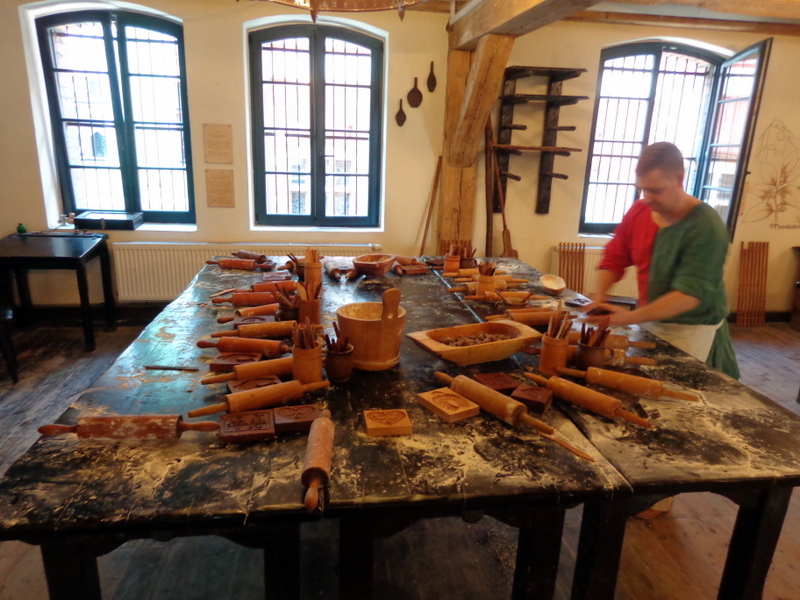 ry of the trade, traditional gingerbread making techniques over the
years, and even make, bake, and decorate their own gingerbread to take
home.
ry of the trade, traditional gingerbread making techniques over the
years, and even make, bake, and decorate their own gingerbread to take
home.
We gathered in a very large room where we saw examples of
gingerbread cookies and large tables for making them. The local guide
for the Museum gave us the history and then showed us how to mix the
ingredients for the dough. We were taken to another large table covered
with rolling pins, knives, molds and large bowls of dough. We kneaded
the dough, and pressed it into a mold of our own choosing. The staff
gather them up and placed them in an oven. When they were done and had
cooled we picked up gingerbread cookie that we had made. They were for
souvenirs and not be eaten as too many people have their hands in the
dough and on the implements.
Kathleen threw hers away, I kept mine. I still have it but it is
looking rather moldy. It was an interesting and somewhat fun
adventure.
Again we were on our own for the rest of the afternoon and for
dinner. We found two churches and visited them.
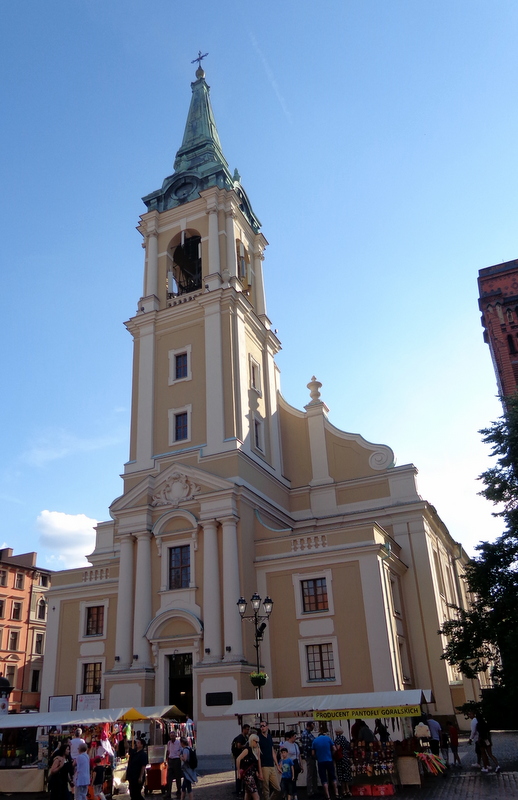 The Holy Spirit Church is a late-Baroque church built in mid-18th
century as an Evangelical church. Its creation is closely connected with
the religious unrest in 1724, in which the local Lutherans lost the
Church of Blessed Virgin Mary, which they previously owned.
The Holy Spirit Church is a late-Baroque church built in mid-18th
century as an Evangelical church. Its creation is closely connected with
the religious unrest in 1724, in which the local Lutherans lost the
Church of Blessed Virgin Mary, which they previously owned.
Deprived of any place of worship within the Old Town, only in 1754
did they receive a royal permit to build a humble house of prayer which
was not to resemble a church in its external appearance. In two years’
time the large church of the Holy Spirit was erected.
The architectural design was prepared by Effraim Schroeger, who
later gained prominence as the leading architect of Polish Classicis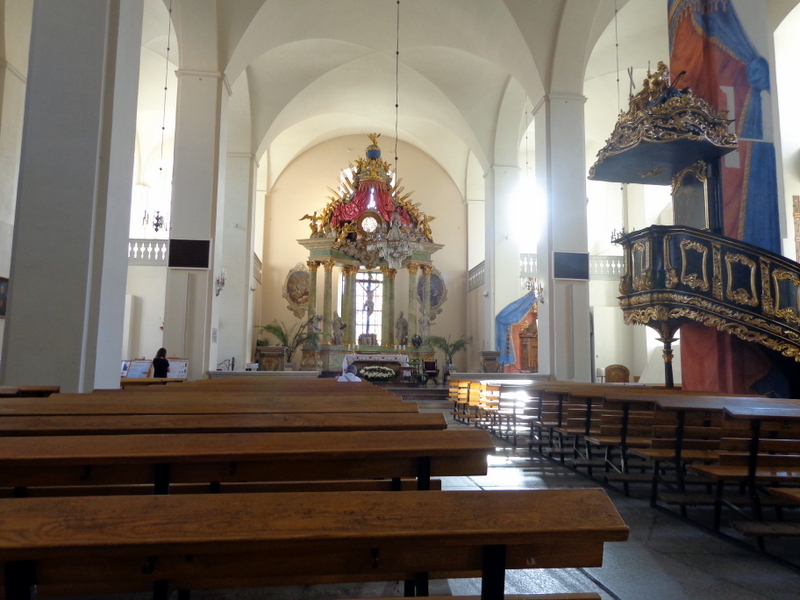 m.
In accordance with the conditions set for its construction, the church
did not have a tower – the one that we can see today was added at the
end of the 19th century. The church was used by Protestants until 1945
when it was taken over by the Jesuits and became the so-called academic
church frequented by the staff and students of the Nicolaus Copernicu
University.
m.
In accordance with the conditions set for its construction, the church
did not have a tower – the one that we can see today was added at the
end of the 19th century. The church was used by Protestants until 1945
when it was taken over by the Jesuits and became the so-called academic
church frequented by the staff and students of the Nicolaus Copernicu
University.
The Gothic church of the Assumption of our Lady was erected in the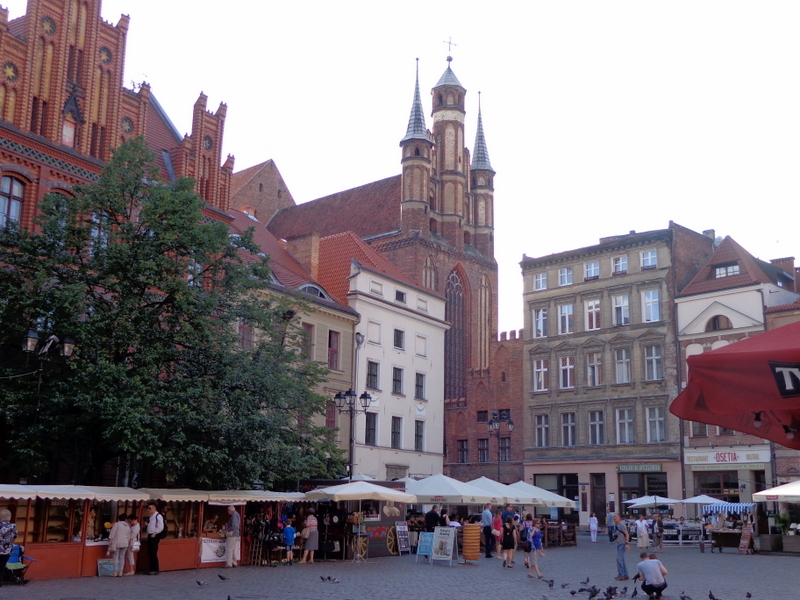 late 14th century by the Franciscans, making use of fragments of the
earlier church and monastery attached to it. In the middle of the 16th
century the church was taken over by the Lutherans. A Protestant grammar
school was founded in the monastery building in 1568. In the early 18th
century the church and monastery were returned to the Catholics. Inside
there are rare Gothic wall paintings from around 1830, late Gothic oak
stalls from the early 15th century, and the Baroque mausoleum of
princess Anna Wazowna from 1636, a rococo main altar from the early
18th century and numerous epitaphs and gravestones.
late 14th century by the Franciscans, making use of fragments of the
earlier church and monastery attached to it. In the middle of the 16th
century the church was taken over by the Lutherans. A Protestant grammar
school was founded in the monastery building in 1568. In the early 18th
century the church and monastery were returned to the Catholics. Inside
there are rare Gothic wall paintings from around 1830, late Gothic oak
stalls from the early 15th century, and the Baroque mausoleum of
princess Anna Wazowna from 1636, a rococo main altar from the early
18th century and numerous epitaphs and gravestones.
We went back to our hotel and sat on the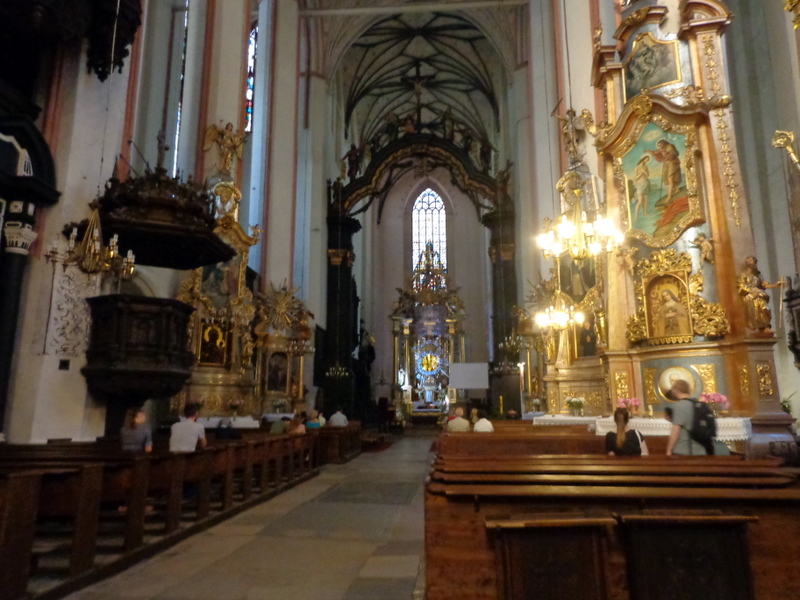 terrace
overlooking the river. We spent some time talking to our tour manager.
We decided to eat at the hotel out on the terrace. We met another
couple coming in, and we had dinner together. Kathleen had fish and I
had a rump steak with a lot of unknown veggies around it. It was good.
terrace
overlooking the river. We spent some time talking to our tour manager.
We decided to eat at the hotel out on the terrace. We met another
couple coming in, and we had dinner together. Kathleen had fish and I
had a rump steak with a lot of unknown veggies around it. It was good.
barracks. The rooms were very nice except for the fact that we only had
one outlet in which to charge our many devices that we carry. In most
hotels in Europe, all of the outlets and lamps are turned off when you
remove the door car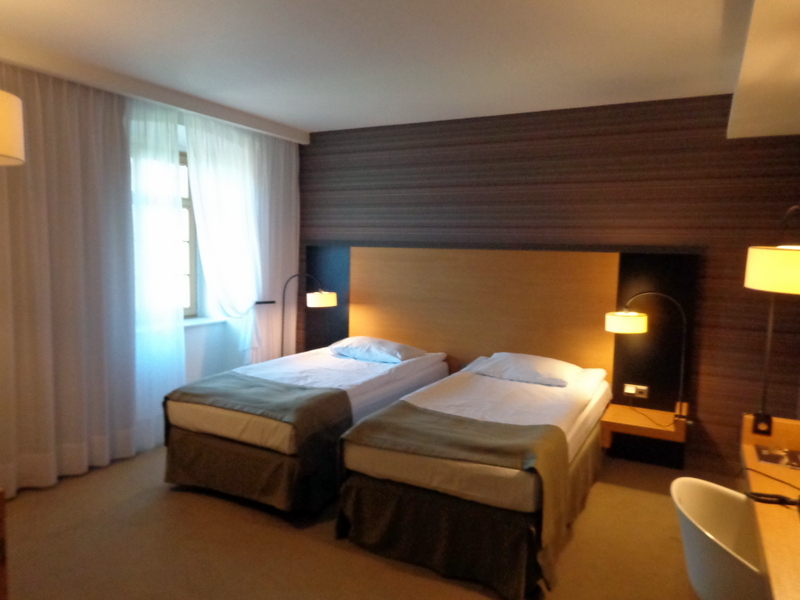 d from a slot that automatically activates the
lights. One of the tricks to keep the lights on while you are away is to
have a his and her door card and leave one card in the switch when you
leave. We counted 18 outlets in our hotel room in Gdansk, more than
enough to take care of cell phones, tablets, laptops and camera
batteries.
d from a slot that automatically activates the
lights. One of the tricks to keep the lights on while you are away is to
have a his and her door card and leave one card in the switch when you
leave. We counted 18 outlets in our hotel room in Gdansk, more than
enough to take care of cell phones, tablets, laptops and camera
batteries.
Day 15 Coming soon

